
A skeleton is a type of physically manifested undead often found in fantasy, gothic, and horror fiction, as well as mythology, folklore, and various kinds of art. Most are human skeletons, but they can also be from any creature or race found on Earth or in the fantasy world.

Warhammer Fantasy is a fictional fantasy universe created by Games Workshop and used in many of its games, including the table top wargame Warhammer Fantasy Battle, the Warhammer Fantasy Roleplay (WFRP) pen-and-paper role-playing game, and a number of video games: the MMORPG Warhammer Online: Age of Reckoning, the strategy games Total War: Warhammer, Total War: Warhammer II and Total War: Warhammer III and the two first-person shooter games in the Warhammer Vermintide series, Warhammer: End Times - Vermintide and Warhammer: Vermintide 2, among many others.
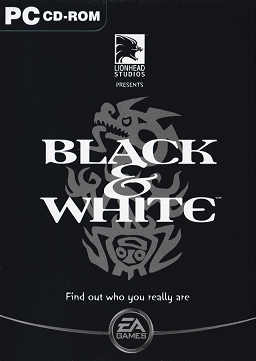
Black & White is a god video game developed by Lionhead Studios and published by Electronic Arts for Microsoft Windows in 2001 and by Feral Interactive in 2002 for Mac OS. Black & White combines elements of artificial life and strategy. The player acts as a god whose goal is to defeat Nemesis, another god who wants to take over the world. A primary theme is the concept of good and evil, with the atmosphere being affected by the player's moral choices. The core gameplay mechanic of Black & White is the interaction between the player and an avatar creature, who carries out the player's instructions and whose personality and behaviour change in reaction to how they are treated. Multiplayer is supported over a local network or online.

Age of Mythology: The Titans is an expansion pack to the real-time strategy video game of Age of Mythology. It was developed by Ensemble Studios and released on October 1, 2003. It was followed in 2016 by a second expansion pack to the original game called Tale of the Dragon.

Dominions II: The Ascension Wars is a 4X turn-based, computer strategy game. It was developed by Illwinter Game Design and published by Shrapnel Games. The game was released on November 14, 2003 in North America for Microsoft Windows, Mac OS X and Linux.
Several video games based on the Magic: The Gathering franchise exist for multiple systems. Some have attempted to translate the card game to electronic play nearly exactly; others have taken more liberties and drawn more from the setting than the actual rules of the card game. Benefits of successful video game versions of the card game include convenience, practice, and challenge. However, artificial intelligence for a game such as Magic is an extremely hard problem, and such software usually must be continuously updated to stay current with recently released card sets. Video game versions often expand on artwork, and may include unique cards that rely on randomness, effects which would be difficult or annoying to duplicate in real life.
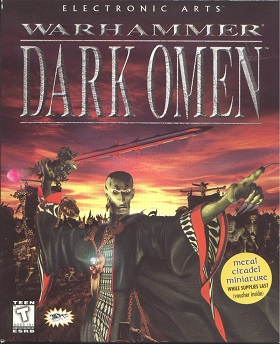
Warhammer: Dark Omen is a fantasy real-time tactical wargame based upon the Warhammer Fantasy Battle table-top game and figurines, and is the sequel to the 1995 game Warhammer: Shadow of the Horned Rat. Developed by Mindscape, in conjunction with Games Workshop, and published by Electronic Arts, the game was released in Spring 1998 for Microsoft Windows and PlayStation. The game's story takes place within the Warhammer Fantasy setting, and focuses on the efforts of a mercenary army to combat a threat to the Old World by a vast army of undead forces led by a powerful entity that has recently arisen.
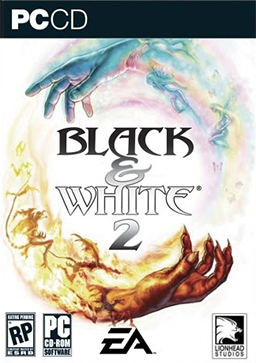
Black & White 2 is a video game developed by Lionhead Studios and published by Electronic Arts released in October 2005. It is the sequel to 2001's Black & White. A Mac OS X port was released in January 2009, and released for download via the Mac App Store in November 2014. The game blends real-time strategy and god game elements.

Age of Mythology (AoM) is a real-time strategy video game developed by Ensemble Studios and published by Microsoft Game Studios. It was released on October 31, 2002 in North America and on November 14, 2002 in Europe.
Risk Godstorm is a Risk variant board game published by Avalon Hill and designed by Mike Selinker with developers Richard Baker and Michael Donais. The cultures of the Celts, Norse, Greeks, Egyptians, and Babylonians clash for supremacy of the ancient world. Players invade territories, play miracle cards, sink Atlantis, and conquer the underworld. The latter is a significant addition to the Risk series, as soldiers do not leave the game when they are killed, but instead go to their heavens and then embark to take over the underworld.

Black & White: Creature Isle is an expansion pack for the PC game Black & White by Lionhead Studios. It was released for Windows in January 2002 and for Mac OS X in December 2002. This expansion pack focuses on the creature and there are no levels as there were in the original game.

Hammer of the Gods is a 1994 turn-based strategy computer game developed by Holistic Design and published by New World Computing for DOS. The events of the game take place in Viking Age Europe, with a Norse fantasy setting. Hammer of the Gods is one of the games that spawned the creation of the Heroes of Might and Magic strategy series.
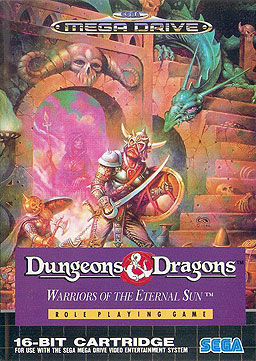
Dungeons & Dragons: Warriors of the Eternal Sun is a role-playing video game developed for the Sega Genesis in 1992 by Westwood Associates. The game tells the story of a party of adventurers who have been transported to an unknown world and must survive against its hostile inhabitants while learning about their new home and seeking allies. It is based on the Dungeons & Dragons (D&D) game rules, and uses creatures and themes from the D&D Hollow World campaign setting, such as Blacklore elves, the Azcans, beastmen, Malpheggi lizardmen, and dinosaurs.
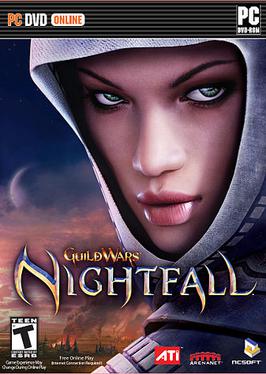
Guild Wars Nightfall is a fantasy action role-playing game and the third stand-alone campaign in the Guild Wars series developed by ArenaNet, a subsidiary of NCSOFT corporation. Nightfall was released worldwide on October 27, 2006, having been in development alongside Guild Wars Factions since November 2005.

Dominions 3: The Awakening is a fantasy turn-based strategy game created by Illwinter and published in 2006 by Shrapnel Games. It is the third game in the Dominions series, preceded by Dominions: Priests, Prophets and Pretenders and Dominions II: The Ascension Wars. Illwinter's publishing contract with Shrapnel Games expired in November 2012 and Dominions 3 was republished on Desura in late December 2012 and soon after on GamersGate. Dominions 3 went through the Greenlight process and was released on Steam in September 2013.
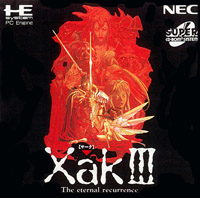
Xak III: The Eternal Recurrence is the final game in a fantasy role-playing video game series called Xak developed and published by the Japanese software developers MicroCabin and NEC. Xak III was originally under development to be released for the MSX2 however shortly after Xak: The Tower of Gazzel was released, the development project was halted. After several years the project was continued and finally released simultaneously for the NEC PC-9801 and FM Towns. A year later, Xak III was released for the PC Engine CD; this version has since been unofficially translated into English.

Miracle Warriors: Seal of the Dark Lord, known as Haja no Fūin in Japan, is a role-playing video game released initially on the Japanese PC-88 and then ported to various other systems, including a Master System port developed by Sega, which was released internationally.
Theros is a set of three expansions to the Magic: The Gathering game, consisting of the sets Theros, Born of the Gods and Journey into Nyx. The setting was later used for a Dungeons & Dragons sourcebook, Mythic Odysseys of Theros (2020). The lore and aesthetics of the game setting was based on Greek mythology.

Total War: Warhammer II is a turn-based strategy and real-time tactics video game developed by Creative Assembly and published by Sega. It is part of the Total War series and the sequel to 2016's Total War: Warhammer. The game is set in Games Workshop's Warhammer Fantasy fictional universe. The game was released for Windows-based PCs on 28 September 2017. Feral Interactive released the game on macOS and Linux on 20 November 2018. Total War: Warhammer II was succeeded by Total War: Warhammer III, which was released in February 2022. The game requires a Steam account to play.

Sylphia is a 1993 vertically scrolling shooter video game developed by Compile and published in Japan by Tonkin House for the PC Engine Super CD-ROM². Whereas many shooting games of the era take place in a science fiction setting, this game instead mixes heroic fantasy and ancient Greek mythology. The game follows Silphia, a maiden warrior reincarnated as a demigoddess under Zeus after her demise in battle, facing against the forces of Hades, who has been possessed and manipulated by the creatures once imprisoned in Tartaros.

















